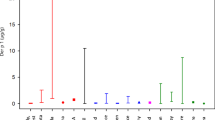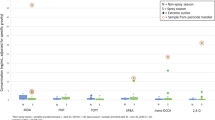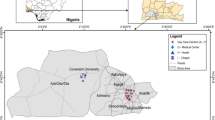Abstract
Human exposure to preformed dialkylphosphates (DAPs) in food or the environment may affect the reliability of DAP urinary metabolites as biomarkers of organophosphate (OP) pesticide exposure. We conducted a study to investigate the presence of DAPs in indoor residential environments and their association with children's urinary DAP levels. We collected dust samples from homes in farmworker and urban communities (40 homes total, n=79 samples) and up to two urine samples from resident children ages 3–6 years. We measured six DAPs in all samples and eight DAP-devolving OP pesticides in a subset of dust samples (n=54). DAPs were detected in dust with diethylphosphate (DEP) being the most frequently detected (≥60%); detection frequencies for other DAPs were ≤50%. DEP dust concentrations did not significantly differ between communities, nor were concentrations significantly correlated with concentrations of chlorpyrifos and diazinon, the most frequently detected diethyl-OP pesticides (Spearman ρ=−0.41 to 0.38, P>0.05). Detection of DEP, chlorpyrifos, or diazinon, was not associated with DEP and/or DEP+diethylthiophosphate detection in urine (Kappa coefficients=−0.33 to 0.16). Finally, estimated non-dietary ingestion intake from DEP in dust was found to be ≤5% of the dose calculated from DEP levels in urine, suggesting that ingestion of dust is not a significant source of DAPs in urine if they are excreted unchanged.
This is a preview of subscription content, access via your institution
Access options
Subscribe to this journal
Receive 6 print issues and online access
$259.00 per year
only $43.17 per issue
Buy this article
- Purchase on Springer Link
- Instant access to full article PDF
Prices may be subject to local taxes which are calculated during checkout

Similar content being viewed by others
Abbreviations
- CDC:
-
Centers for Disease Control and Prevention
- DAP:
-
dialkylphosphate
- DE:
-
diethyl
- DEP:
-
diethylphosphate
- DEDTP:
-
diethyldithiophosphate
- DETP:
-
diethylthiophosphate
- DF:
-
detection frequency
- DM:
-
dimethyl
- DMP:
-
dimethylphosphate
- DMDTP:
-
dimethyldithiophosphate
- DMTP:
-
dimethylthiophosphate
- EPA:
-
Environmental Protection Agency
- GC-MS/MS:
-
gas chromatography-tandem mass spectrometry
- LOD:
-
limits of detection
- OP:
-
organophosphate
- QC:
-
quality control
References
Bouchard M.F., Bellinger D.C., Wright R.O., and Weisskopf M.G. Attention-deficit/hyperactivity disorder and urinary metabolites of organophosphate pesticides. Pediatrics 2010: 125: e1270–e1277.
Bouchard M.F., Chevrier J., Harley K.G., Kogut K., Vedar M., and Calderon N., et al. Prenatal exposure to organophosphate pesticides and IQ in 7-year-old children. Environ Health Perspect 2011: 119: 1189–1195.
Engel S.M., Berkowitz G.S., Barr D.B., Teitelbaum S.L., Siskind J., and Meisel S.J., et al. Prenatal organophosphate metabolite and organochlorine levels and performance on the Brazelton Neonatal Behavioral Assessment Scale in a multiethnic pregnancy cohort. Am J Epidemiol 2007: 165: 1397–1404.
Eskenazi B., Marks A., Bradman A., Harley K., Barr D., and Johnson C., et al. Organophosphate pesticide exposure and neurodevelopment in young Mexican-American children. Environ Health Perspect 2007: 115: 792–798.
Marks A., Harley K., Bradman A., Kogut K., Johnson C., and Barr D., et al. Organophosphate pesticide exposure and attention in young Mexican-American children: The CHAMACOS Study. Environ Health Perspect 2010: 118: 1768–1774.
Barr D.B., and Angerer J. Potential uses of biomonitoring data: a case study using the organophosphorus pesticides chlorpyrifos and malathion. Environ Health Perspect 2006: 114: 1763–1769.
U.S. EPA. Pesticide reregistration status for organophosphates. Available at http://www.epa.gov/pesticides/reregistration/status_op.htm(accessed on: March 2010).
Bravo R., Caltabiano L.M., Weerasekera G., Whitehead R.D., Fernandez C., and Needham L.L., et al. Measurement of dialkyl phosphate metabolites of organophosphorus pesticides in human urine using lyophilization with gas chromatography-tandem mass spectrometry and isotope dilution quantification. J Expo Anal Environ Epidemiol 2004: 14: 249–259.
Weerasekera G., Smith K.D., Quirós-Alcalá L., Fernandez C., Bradman A., and Eskenazi B., et al. A mass spectrometry-based method to measure dialkylphosphate degradation products of organophosphorous insecticides in dust and orange juice. J Environ Monit 2009: 11: 1345–1351.
Castorina R., Bradman A., McKone T.E., Barr D.B., Harnly M.E., and Eskenazi B. Cumulative organophosphate pesticide exposure and risk assessment among pregnant women living in an agricultural community: a case study from the CHAMACOS cohort. Environ Health Perspect 2003: 111: 1640–1648.
Fenske R.A., Kissel J.C., Lu C., Kalman D.A., Simcox N.J., and Allen E.H., et al. Biologically based pesticide dose estimates for children in an agricultural community. Environ Health Perspect 2000: 108: 515–520.
Krieger R.I., Dinoff T.M., Williams R.L., Zhang X., Ross J.H., and Aston L.S., et al. Correspondence: preformed biomarkers in produce inflate human organophosphate exposure assessments. Environ Health Perspect 2003: 111: A688–A689; author reply A689–691.
Morgan M.K., Sheldon L.S., Croghan C.W., Jones P.A., Robertson G.L., and Chuang J.C., et al. Exposures of preschool children to chlorpyrifos and its degradation product 3,5,6-trichloro-2-pyridinol in their everyday environments. J Expo Anal Environ Epidemiol 2005: 15: 297–309.
Racke J.D. Degradation of organophosphorous insecticidesin environmental matrices. In: Organophosphates Chemistry, Fate and Effects. Academic Press, Inc., San Diego, CA, 1992, pp 47–72.
Lu C., Bravo R., Caltabiano L.M., Irish R.M., Weerasekera G., and Barr D.B. The presence of dialkylphosphates in fresh fruit juices: implication for organophosphorus pesticide exposure and risk assessments. J Toxicol Environ Health A 2005: 68: 209–227.
Zhang X., Driver J.H., Li Y., Ross J.H., and RI K. Dialkylphosphates (DAPs) in fruits and vegetables may confound biomonitoring in organophosphorus insecticide exposure and risk assessment. J Agric Food Chem 2008: 56: 10638–10645.
Forsberg N.D., Rodriguez-Proteau R., Ma L., Morre J., Christensen JM., and Maier C.S., et al. Organophosphorus pesticide degradation product in vitro metabolic stability and time-course uptake and elimination in rats following oral and intravenous dosing. Xenobiotica 2011: 41: 422–429.
Timchalk C., Busby A., Campbell J.A., Needham L.L., and Barr D.B. Comparative pharmacokinetics of the organophosphorus insecticide chlorpyrifos and its major metabolites diethylphosphate, diethylthiophosphate and 3,5,6-trichloro-2-pyridinol in the rat. Toxicology 2007: 237: 145–157.
Butte W., and Heinzow B. Pollutants in house dust as indicators of indoor contamination. Rev Environ Contam Toxicol 2002: 175: 1–46.
Ott W.R., Steinemann A.C., and Wallace L.A., (Eds.) Exposure Analysis. CRC Press, Boca Raton, 2007.
Roberts J.W., Wallace L.A., Camann D.E., Dickey P., Gilbert S.G., and Lewis R.G., et al. Monitoring and reducing exposure of infants to pollutants in house dust. Rev Environ Contam Toxicol 2009: 201: 1–39.
ASTM. ASTM-D-5438-94 Standard Practice for Collection of Floor Dust for Chemical Analysis. Annual Book of ASTM Standards. American Society for Testing and Materials, Philadephia, PA, 1994 pp 570–571.
Quirós-Alcalá L., Bradman A., Nishioka M., Harnly M.E., Hubbard A., and McKone T.E., et al. Pesticides in house dust from urban and farmworker households in California: an observational measurement study. Environ Health 2011: 10: 19.
Westgard J.O. Tools, Technology, and Training for Healthcare Laboratories. Westgard QC, 2003. Available at http://www.westgard.com (accessed on Jan 2009).
Barr D.B. Biomonitoring of exposure to pesticides. J Chem Health Safety 2008: 15: 20–29.
U.S. EPA. Child-Specific Exposure Factors Handbook (Final Report), EPA/600/R-06/096F. U.S. Environmental Protection Agency, Washington, DC, 2008. EPA/600/R-06/096F. Available at http://www.epa.gov/fedrgstr/EPA-IMPACT/2008/October/Day-30/i25908.htm (accessed 1 March 2009).
U.S. Department of Health and Human Services.. The 2006 HHS Poverty Guidelines 2009. U.S. Department of Health and Human Services, Washington, D.C., 2006.
U.S. EPA. Chlorpyrifos Revised Risk Assessment and Agreement with Registrants, (http://www.epa.gov/pesticides/op/chlorpyrifos/agreement.pdf). Office of Prevention, Pesticides, and Toxic Substances, Washington, DC, 2000 pp 1–4.
U.S. EPA. Diazinon Revised Risk Assessment and Agreement with Registrants, (http://www.ok.gov/∼okag/forms/cps/epaagree.pdf). Office of Prevention, Pesticides, and Toxic Substances, Washington, DC, 2001 pp 1–4.
CDC. The Fourth National Report on Human Exposure to Environmental Chemicals, 2009. Department of Health and Human Services. Available at http://www.cdc.gov/exposurereport/ (accessed 15 Jan 2010).
Fenske R.A., Lu C., Curl C.L., Shirai J.H., and Kissel J.C. Biologic monitoring to characterize organophosphorus pesticide exposure among children and workers: an analysis of recent studies in Washington State. Environ Health Perspect 2005: 113: 1651–1657.
Acknowledgements
This work was supported by EPA (RD 83171001) and NIEHS (PO1 ES009605). Its contents are solely the responsibility of the authors and do not necessarily represent the official views of the EPA, NIEHS, or other funders. Additional support was provided by an EPA STAR Doctoral Fellowship (F5D30812), the University of California Institute for Mexico and the United States (UC MEXUS), and the Center for Latino Policy Research at the University of California at Berkeley. We thank the CHAMACOS staff, community partners including Drs. John Pescetti and Claire Horton at Clinica de la Raza for their support in recruitment efforts, our study participants, Dr. Do-Gyun Kim and Carolina Fernandez from the Pesticide Toxicology Laboratory at the CDC for their assistance with urine sample analysis, and Dr. Rosana Weldon for editorial comments.
Author information
Authors and Affiliations
Corresponding author
Ethics declarations
Competing interests
The authors declare no conflict of interest.
Rights and permissions
About this article
Cite this article
Quirós-Alcalá, L., Bradman, A., Smith, K. et al. Organophosphorous pesticide breakdown products in house dust and children's urine. J Expo Sci Environ Epidemiol 22, 559–568 (2012). https://doi.org/10.1038/jes.2012.46
Received:
Accepted:
Published:
Issue Date:
DOI: https://doi.org/10.1038/jes.2012.46
Keywords
This article is cited by
-
Urinary dialkylphosphate metabolites in the assessment of exposure to organophosphate pesticides: from 2000 to 2022
Environmental Monitoring and Assessment (2024)
-
Pesticides in indoor and outdoor residential dust: a pilot study in a rural county of Taiwan
Environmental Science and Pollution Research (2018)
-
Distributions and determinants of urinary biomarkers of organophosphate pesticide exposure in a prospective Spanish birth cohort study
Environmental Health (2017)
-
Characterization of Pesticide Exposure in a Sample of Pregnant Women in Ecuador
Archives of Environmental Contamination and Toxicology (2016)
-
Home-based community health worker intervention to reduce pesticide exposures to farmworkers’ children: A randomized-controlled trial
Journal of Exposure Science & Environmental Epidemiology (2015)



